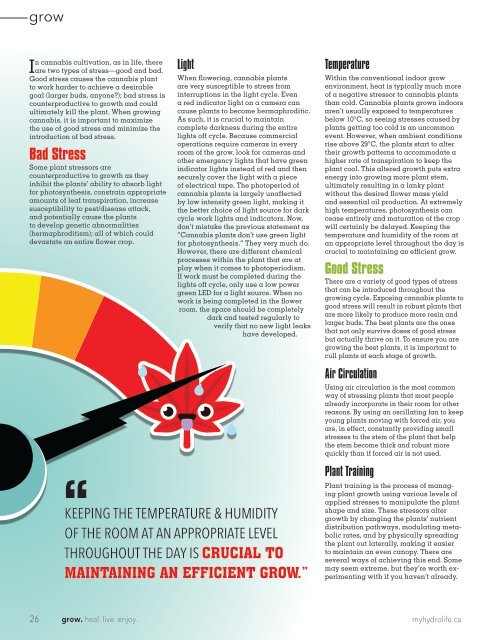Hydrolife Magazine April/May 2017 (Canada Edition)
To know where you’re going, you have to know where you’ve been. The adage rings true for the modern cannabis industry, which is why this issue of Hydrolife takes a look back at the roots of marijuana and how the plant has traveled through history in North America (History of Cannabis Part II).
To know where you’re going, you have to know where you’ve been. The adage rings true for the modern cannabis industry, which is why this issue of Hydrolife takes a look back at the roots of marijuana and how the plant has traveled through history in North America (History of Cannabis Part II).
Create successful ePaper yourself
Turn your PDF publications into a flip-book with our unique Google optimized e-Paper software.
grow<br />
In cannabis cultivation, as in life, there<br />
are two types of stress—good and bad.<br />
Good stress causes the cannabis plant<br />
to work harder to achieve a desirable<br />
goal (larger buds, anyone?); bad stress is<br />
counterproductive to growth and could<br />
ultimately kill the plant. When growing<br />
cannabis, it is important to maximize<br />
the use of good stress and minimize the<br />
introduction of bad stress.<br />
Bad Stress<br />
Some plant stressors are<br />
counterproductive to growth as they<br />
inhibit the plants’ ability to absorb light<br />
for photosynthesis, constrain appropriate<br />
amounts of leaf transpiration, increase<br />
susceptibility to pest/disease attack,<br />
and potentially cause the plants<br />
to develop genetic abnormalities<br />
(hermaphroditism); all of which could<br />
devastate an entire flower crop.<br />
Light<br />
When flowering, cannabis plants<br />
are very susceptible to stress from<br />
interruptions in the light cycle. Even<br />
a red indicator light on a camera can<br />
cause plants to become hermaphroditic.<br />
As such, it is crucial to maintain<br />
complete darkness during the entire<br />
lights off cycle. Because commercial<br />
operations require cameras in every<br />
room of the grow, look for cameras and<br />
other emergency lights that have green<br />
indicator lights instead of red and then<br />
securely cover the light with a piece<br />
of electrical tape. The photoperiod of<br />
cannabis plants is largely unaffected<br />
by low intensity green light, making it<br />
the better choice of light source for dark<br />
cycle work lights and indicators. Now,<br />
don’t mistake the previous statement as<br />
“Cannabis plants don’t use green light<br />
for photosynthesis.” They very much do.<br />
However, there are different chemical<br />
processes within the plant that are at<br />
play when it comes to photoperiodism.<br />
If work must be completed during the<br />
lights off cycle, only use a low power<br />
green LED for a light source. When no<br />
work is being completed in the flower<br />
room, the space should be completely<br />
dark and tested regularly to<br />
verify that no new light leaks<br />
have developed.<br />
Temperature<br />
Within the conventional indoor grow<br />
environment, heat is typically much more<br />
of a negative stressor to cannabis plants<br />
than cold. Cannabis plants grown indoors<br />
aren’t usually exposed to temperatures<br />
below 10°C, so seeing stresses caused by<br />
plants getting too cold is an uncommon<br />
event. However, when ambient conditions<br />
rise above 29°C, the plants start to alter<br />
their growth patterns to accommodate a<br />
higher rate of transpiration to keep the<br />
plant cool. This altered growth puts extra<br />
energy into growing more plant stem,<br />
ultimately resulting in a lanky plant<br />
without the desired flower mass yield<br />
and essential oil production. At extremely<br />
high temperatures, photosynthesis can<br />
cease entirely and maturation of the crop<br />
will certainly be delayed. Keeping the<br />
temperature and humidity of the room at<br />
an appropriate level throughout the day is<br />
crucial to maintaining an efficient grow.<br />
Good Stress<br />
There are a variety of good types of stress<br />
that can be introduced throughout the<br />
growing cycle. Exposing cannabis plants to<br />
good stress will result in robust plants that<br />
are more likely to produce more resin and<br />
larger buds. The best plants are the ones<br />
that not only survive doses of good stress<br />
but actually thrive on it. To ensure you are<br />
growing the best plants, it is important to<br />
cull plants at each stage of growth.<br />
Air Circulation<br />
Using air circulation is the most common<br />
way of stressing plants that most people<br />
already incorporate in their room for other<br />
reasons. By using an oscillating fan to keep<br />
young plants moving with forced air, you<br />
are, in effect, constantly providing small<br />
stresses to the stem of the plant that help<br />
the stem become thick and robust more<br />
quickly than if forced air is not used.<br />
“<br />
KEEPING THE TEMPERATURE & HUMIDITY<br />
OF THE ROOM AT AN APPROPRIATE LEVEL<br />
THROUGHOUT THE DAY IS CRUCIAL TO<br />
MAINTAINING AN EFFICIENT GROW.”<br />
Plant Training<br />
Plant training is the process of managing<br />
plant growth using various levels of<br />
applied stresses to manipulate the plant<br />
shape and size. These stressors alter<br />
growth by changing the plants’ nutrient<br />
distribution pathways, modulating metabolic<br />
rates, and by physically spreading<br />
the plant out laterally, making it easier<br />
to maintain an even canopy. There are<br />
several ways of achieving this end. Some<br />
may seem extreme, but they’re worth experimenting<br />
with if you haven’t already.<br />
26<br />
grow. heal. live. enjoy.<br />
myhydrolife.ca




![Hydrolife Magazine December 2017/January 2018 [CANADIAN EDITION]](https://img.yumpu.com/59790088/1/190x247/hydrolife-magazine-december-2017-january-2018-canadian-edition.jpg?quality=85)
![Hydrolife Magazine December 2017/January 2018 [USA EDITION]](https://img.yumpu.com/59790042/1/190x247/hydrolife-magazine-december-2017-january-2018-usa-edition.jpg?quality=85)
![Hydrolife Magazine October/November 2017 [Canada Edition]](https://img.yumpu.com/59493562/1/190x247/hydrolife-magazine-october-november-2017-canada-edition.jpg?quality=85)
![Hydrolife Magazine October/November 2017 [USA Edition]](https://img.yumpu.com/59493548/1/190x247/hydrolife-magazine-october-november-2017-usa-edition.jpg?quality=85)
![Hydrolife Magazine August/September 2017 [USA Edition]](https://img.yumpu.com/59236656/1/190x247/hydrolife-magazine-august-september-2017-usa-edition.jpg?quality=85)








